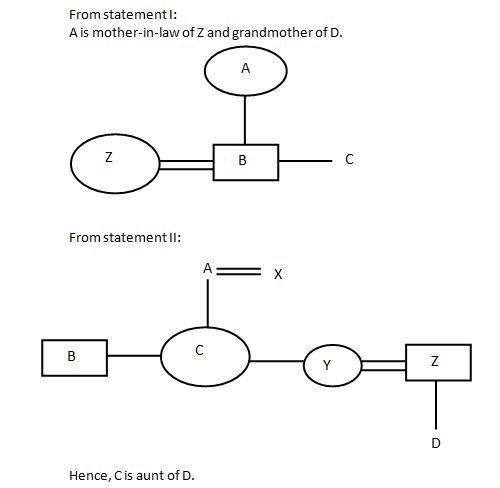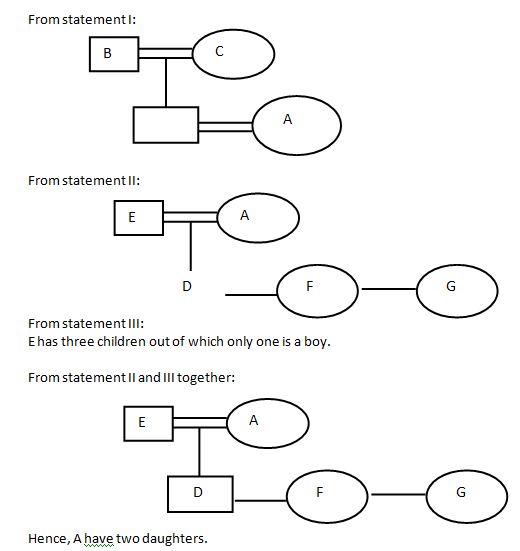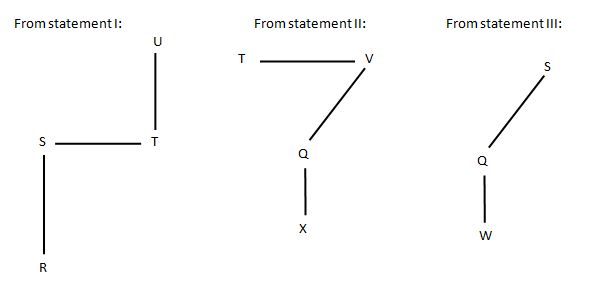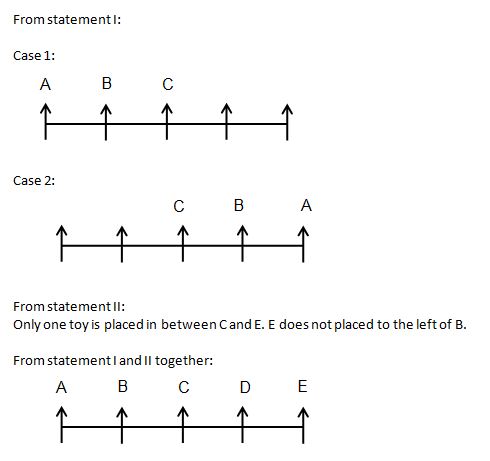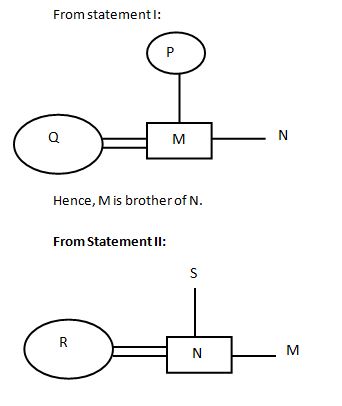Welcome to Online Quantitative Aptitude section in AffairsCloud.com. Here we are creating question sample From DATA SUFFICIENCY which is BASED ON Bank EXAMS !!!
Data Sufficiency
(Directions 1 – 10): Study the following information and answer the questions given below:
- Seven persons X, Y, Z, A, B, C and D are belonging to the same family and it is a family of three-generation and there are two married couples in the family. How is C related to D?
I. B is brother of C and son of A. A is mother-in-law of Z and grandmother of D. Z is not married to C.
II. C is daughter of A and sister of Y. B is son of X and brother-in-law of Z. Z is father of D. Z is not married to C.
1) The data in statement II alone are sufficient to answer the question, while the data in statement I alone are not sufficient to answer the question
2) The data even in both statements I and II together are not sufficient to answer the question
3) The data either in statement I alone or in statement II alone are sufficient to answer the question
4) The data in statement I alone are sufficient to answer the question, while the data in statement II alone are not sufficient to answer the question
5) The data in both statements I and II together are necessary to answer the questionAnswer – 1) The data in statement II alone are sufficient to answer the question, while the data in statement I alone are not sufficient to answer the question
Explanation :

- Who among the following U, V, W, X, Y and Z is the highest score in the class?
I. X is highest scorer than U and W. X is less scorer than V. Y is higher scorer than only Z.
II. Y is higher scorer than W but lesser scorer than U. Z is highest scorer than only X. U is not the highest scorer.
1) If the data in statement I alone are sufficient to answer the question, while the data in statement II alone are not sufficient to answer the question.
2) If the data in statement II alone are sufficient to answer the question, while the data in statement I alone are not sufficient to answer the question.
3) If the data either in statement I alone or in statement II alone are sufficient to answer the question.
4) If the data even in both statements I and II together are not sufficient to answer the question.
5) If the data in both statement I and II together are necessary to answer the question.Answer – 3) If the data either in statement I alone or in statement II alone are sufficient to answer the question.
Explanation :
From statement I – V > X > U/W > Y > Z
Hence, V is the highest scorer.
From statement II – V > U > Y > W > Z > X
Hence, V is the highest scorer. - In a metro, some persons are standing in a straight line. How many persons are standing in a straight line, if all of them are facing in the north direction?
I. Only one person is standing to the left of M. Only two persons are standing between M and N. N is standing to immediate right to of O. O is standing exactly in the middle of the metro.
II. Only three persons are standing to the left of O. Only two persons are standing between O and P. P is standing at the extreme right end in the metro.
1) The data in statement II alone are sufficient to answer the question, while the data in statement I alone are not sufficient to answer the question
2) The data even in both statements I and II together are not sufficient to answer the question
3) The data either in statement I alone or in statement II alone are sufficient to answer the question
4) The data in statement I alone are sufficient to answer the question, while the data in statement II alone are not sufficient to answer the question
5) The data in both statements I and II together are necessary to answer the questionAnswer – 3) The data either in statement I alone or in statement II alone are sufficient to answer the question
Explanation :

- A has how many daughters?
I. B is husband of C and father-in-law of A who has three Children.
II. D’s father E is husband of A. F and G are sisters of D.
III. E has three children out of which only one is a boy.
1) Only statement I is required
2) Only statement II is required
3) Both I and III required
4) Both II and III required
5) Question cannot be answered even with all the statements together.Answer – 4) Both II and III required
Explanation :

- ‘Q’ is in which direction with respect to ‘R’?
I. S is north of R and west of T who is south of U.
II. T is west of V who is north east of Q who is north of X.
III. Q is north of W and south west of S.
1) If the data in statement I and II are sufficient to answer the question, while the data in statement III are not sufficient to answer the question.
2) If the data in statement I and III are sufficient to answer the question, while the data in statement II is not sufficient to answer the question.
3) If the data in statement II and III are sufficient to answer the question, while the data in statement I is not sufficient to answer the question.
4) If the data in statement I alone or in the statement II alone or in the statement III alone is sufficient to answer the question.
5) If the data in all the statement I, II and III together are not sufficient to answer the question.Answer – 5) If the data in all the statement I, II and III together are not sufficient to answer the question.
Explanation :

- Who among the following is second to the left of E?
I. Five toys A, B, C, D and E are placed in a row in north direction. A is placed at one of the extreme end. B is placed exactly in between A and C.
II. Only one toy is placed in between C and E. E does not placed to the left of B.
1) The data in statement II alone are sufficient to answer the question, while the data in statement I alone are not sufficient to answer the question
2) The data even in both statements I and II together are not sufficient to answer the question
3) The data either in statement I alone or in statement II alone are sufficient to answer the question
4) The data in statement I alone are sufficient to answer the question, while the data in statement II alone are not sufficient to answer the question
5) The data in both statements I and II together are necessary to answer the questionAnswer – 5) The data in both statements I and II together are necessary to answer the question
Explanation :

- How is M related to N?
I. P, who has only two kids, M & N, is the mother-in-law of Q, who is sister-in-law of N.
II. R, the sister-in-law of M, is the daughter-in-law of S, who has only two kids, M & N.
1) Data in Statement I alone are sufficient to answer the question, while the data in Statement II alone are not sufficient to answer the question.
2) Data in Statement II alone are sufficient to answer the question, while the data in Statement I alone are not sufficient to answer the question.
3) Data either in Statement I alone or in Statement II alone are sufficient to answer the question.
4) Data in both the Statements I and II together are not sufficient to answer the question.
5) Data in both the Statements I and II together are necessary to answer the question.Answer – 1) Data in Statement I alone are sufficient to answer the question, while the data in Statement II alone are not sufficient to answer the question.
Explanation :

- Which of the following will indicate colour of clear sky in a coding system?
I. ‘Indigo’ means ‘Grey’, ‘Grey’ means ‘Black’, Black’ means ‘Blue’ in that system.
II. ‘Black’ means ‘Blue’, ‘Blue’ means ‘Orange’; Orange’ means ‘Green’ in that system.
1) Data in Statement I alone are sufficient to answer the question, while the data in Statement II alone are not sufficient to answer the question.
2) Data in Statement II alone are sufficient to answer the question, while the data in Statement I alone are not sufficient to answer the question.
3) Data either in Statement I alone or in Statement II alone are sufficient to answer the question.
4) Data in both the Statements I and II together are not sufficient to answer the question.
5) Data in both the Statements I and II together are necessary to answer the question.Answer – 2) Data in Statement II alone are sufficient to answer the question, while the data in Statement I alone are not sufficient to answer the question.
Explanation :
From statement 1:
‘Indigo’ means ‘Grey’, ‘Grey’ means ‘Black’, Black’ means ‘Blue’
Here code for blue is not mentioned.
From statement 2:
‘Black’ means ‘Blue’, ‘Blue’ means ‘Orange’, ‘ Orange’ means ‘Green’
Clearly it is given that ‘blue means orange’.
Hence, colour of clear sky is orange. - Eight actors A, B, C, D, E, F, G and H are standing in a straight line facing north but not necessarily in the same order. B is standing second to the right of F. F is standing at one of the extreme end of the line, then what is the standing position of D?
I. G is not the immediate neighbour of E and C is standing third to the left of D.
II. Only two persons are standing between D and A.
1) The data in statement II alone are sufficient to answer the question, while the data in statement I alone are not sufficient to answer the question
2) The data even in both statements I and II together are not sufficient to answer the question
3) The data either in statement I alone or in statement II alone are sufficient to answer the question
4) The data in statement I alone are sufficient to answer the question, while the data in statement II alone are not sufficient to answer the question
5) The data in both statements I and II together are necessary to answer the questionAnswer – 5) The data in both statements I and II together are necessary to answer the question
Explanation :

- Who among A, B, C, D and E is the best painter?
I. D is better painter than E, A and C but not as better as B.
II. D is better painter than C but not as better as B who is better painter than E.
1) The data in statement II alone are sufficient to answer the question, while the data in statement I alone are not sufficient to answer the question
2) The data even in both statements I and II together are not sufficient to answer the question
3) The data either in statement I alone or in statement II alone are sufficient to answer the question
4) The data in statement I alone are sufficient to answer the question, while the data in statement II alone are not sufficient to answer the question
5) The data in both statements I and II together are necessary to answer the questionAnswer – 4) The data in statement I alone are sufficient to answer the question, while the data in statement II alone are not sufficient to answer the question
Explanation :
From statement I:
D > E, A and C, B > D
B > D > E, A and C
Hence, B is the best painterFrom statement II:
D > C, B > D, B > E
AffairsCloud Recommends Oliveboard Mock Test
AffairsCloud Ebook - Support Us to Grow
Govt Jobs by Category
Bank Jobs Notification


